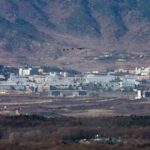![[단독] 윤석열 정부 軍방위력개선비 2년 연속 30%↓…병사 봉급 인상에 ‘전력 증강 제약’[이현호 기자의 밀리터리!톡]](https://contents-cdn.viewus.co.kr/image/2024/03/CP-2023-0094/image-1ef40c43-1a99-4560-a77e-441a418208f3.jpeg)
The Yoon Suk Yeol government has seen a decrease in the proportion of the defense improvement budget allocated for introducing advanced weapons and research and development costs to enhance defense capabilities.
In particular, it is pointed out that the proportion of defense improvement costs fell below 30% for the first time in eight years last year, and it is also staying in the 29% range this year, restricting major power enhancement projects for two consecutive years.
According to an analysis by the Seoul Economic Newspaper on the 2024 Defense Budget, the total amount is around $44 billion. The defense improvement budget is $13 billion, and the power operation budget for military power operations is $31 billion. The defense improvement budget increased by 4.3% compared to the previous year (around $12.5 billion), accounting for 29.7%. On the other hand, the power operation budget recorded 70.2% of the total amount.
Accordingly, it is pointed out that the defense improvement budget fell below 30% for the first time in eight years last year and does not exceed 30% this year as well, showing the possibility that projects to enhance military power may be significantly reduced.
A military expert pointed out, “Projects to introduce various advanced powers, including the three-axis system, need to be carried out quickly in response to the sophistication of North Korea’s nuclear and missile capabilities. However, focusing on soldier salary increases and welfare can restrict power enhancement, such as introducing advanced weapon systems.”
The National Assembly is also voicing concerns about the decreasing trend of the defense improvement budget by the Ministry of Defense. The National Assembly Budget Office also pointed out in its 2024 budget analysis report that the rapid increase in soldier salaries and welfare is constraining the defense budget’s operation.
An official of the National Assembly Budget Office expressed concern, saying, “The problem of improving the treatment of soldiers and military personnel triggered by the increase in soldier salaries acts as a factor for increasing the scale of personnel operation costs. This can increase the proportion of personnel operation costs and decrease the proportion of defense improvement costs and power maintenance costs in the defense budget.”
◇Yearly Defense Budget Trend
(Unit: won)
| Year | Defense Budget | Power Operation Cost (Increase Rate) | Power Operation Cost Proportion | Defense Improvement Cost (Increase Rate) | Defense Improvement Cost Proportion |
| 2014 | 35.7056 trillion | 25.1960 trillion (3.6%) | 70.6% | 10.5096 trillion (3.3%) | 29.4% |
| 2015 | 37.4560 trillion | 26.4420 trillion (4.9%) | 70.6% | 11.0140 trillion (4.8%) | 29.4% |
| 2016 | 38.7995 trillion | 27.1597 trillion (2.7%) | 70% | 11.6398 trillion (5.7%) | 30% |
| 2017 | 40.3347 trillion | 28.1377 trillion (3.6%) | 69.8% | 12.1970 trillion (4.8%) | 30.2% |
| 2018 | 43.1581 trillion | 29.6378 trillion (5.3%) | 68.7% | 13.5203 trillion (10.8%) | 31.3% |
| 2019 | 46.6971 trillion | 31.3238 trillion (5.7%) | 67.1% | 15.3733 trillion (13.7%) | 32.9% |
| 2020 | 50.1527 trillion | 33.4723 trillion (6.9%) | 66.7% | 16.6804 trillion (8.5%) | 33.3% |
| 2021 | 52.8401 trillion | 35.8437 trillion (7.1%) | 67.8% | 16.9964 trillion (1.9%) | 32.2% |
| 2022 | 54.6112 trillion | 37.9195 trillion (5.8%) | 69.4% | 16.6917 trillion (-1.8%) | 30.6% |
| 2023 | 57.0143 trillion | 40.0974 trillion (5.7%) | 70.3% | 16.9169 trillion (1.3%) | 29.6% |
| 2024 | 59.4244 trillion | 41.7712 trillion (4.2%) | 70.2% | 17.6532 trillion (4.3%) | 29.7% |
Internally, the military views securing 30% of the defense improvement cost as the minimum Maginot line. Suppose a specific part of the defense budget is not invested in new power enhancement in the presence of military threats on the Korean Peninsula and is concentrated on the operation of existing powers and forces. In that case, it can face limitations in improving military power. In particular, if it fails to acquire the ability to cope with unexpected advanced weapon attacks by enemy countries during a crisis provocation, it means missing the military preparation period. On a national level, it can act as an anxiety factor that darkens the future of defense industry development.
The defense improvement budget improves military power through the purchase, new development, and performance improvement of weapon systems. The power operation budget operates military power through personnel costs, maintenance of equipment, construction of facilities, etc.
In response, the military authorities emphasized that the defense improvement budget is somewhat decreasing since large-scale projects such as the development of the Korean fighter KF-21 and the Korean next-generation destroyer (KDDX) project entered the final stage. They said that when the second project of the next-generation fighter (F-X), the introduction of military reconnaissance satellites, and the domestic tactical transport aircraft project (MC-X) are in full swing, the proportion of defense improvement costs will increase again.
![[단독] 윤석열 정부 軍방위력개선비 2년 연속 30%↓…병사 봉급 인상에 ‘전력 증강 제약’[이현호 기자의 밀리터리!톡]](https://contents-cdn.viewus.co.kr/image/2024/03/CP-2023-0094/image-034a08b4-12bf-48a5-a4af-52600d1e5d14.jpeg)
What is clear is that the proportion of the defense improvement budget is on a downward trend. The proportion of the defense improvement budget fell below 30% for the first time in eight years since 2015 last year, and it is also falling below 30% this year, showing a stumbling trend for two consecutive years. The ratio of defense improvement budget showed an upward trend until 2020 due to the massive defense investment of the Moon Jae In government since 2015. Still, it has been falling since then, falling below 30% since the current government.
They argue that the defense budget policy focusing on soldier salary increases and welfare reduces investment capacity for military power improvement.
What is more noteworthy is that the government is changing the classification criteria of items in the defense budget to increase the proportion of the defense improvement budget, but that proportion is continuously decreasing. According to an analysis by the National Assembly Budget Office, The Ministry of National Defense will move training munitions, which had been classified as power operation costs, to items of the outsourced depot maintenance and life extension of guided munitions beginning in the 2021 budget, and Initial operating stabilization projects will be counted as the defense improvement budget starting in 2022. In the 2022 budget, these costs are estimated to be around $800 million. If they are changed to the defense improvement budget, the proportion of the defense improvement budget in the defense budget is expected to increase by 2%p.
The National Assembly Budget Office suggested, “There are limitations in increasing the proportion of the defense improvement budget in the defense budget composition as fixed costs and other rigidity costs in the defense field are increasing. Populist policies that hinder flexibility in the future distribution of defense resources and limit the proper composition of defense improvement costs should be placed at a lower priority.”















Most Commented